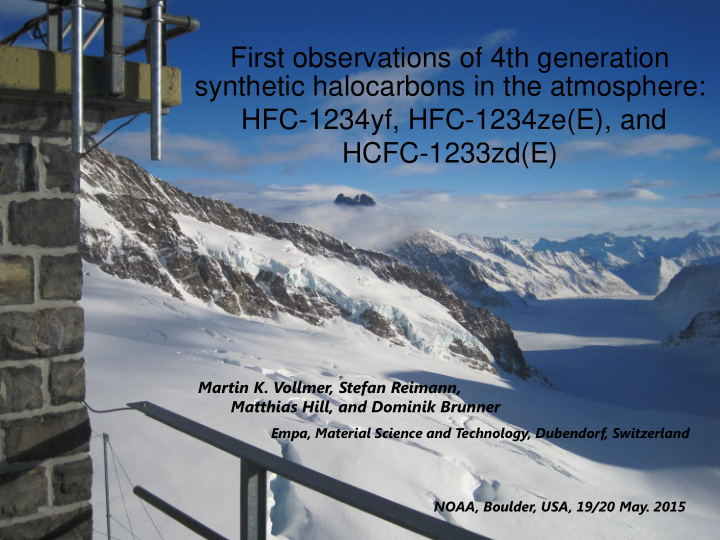



First observations of 4th generation synthetic halocarbons in the atmosphere: HFC-1234yf, HFC-1234ze(E), and HCFC-1233zd(E) Martin K. Vollmer, Stefan Reimann, Matthias Hill, and Dominik Brunner Empa, Material Science and Technology, Dubendorf, Switzerland NOAA, Boulder, USA, 19/20 May. 2015
History of synthetic halogenated compounds 1950s: 1 st generation: chlorofluorocarbons (CFCs), halons: Cl, F, Br, - 1990s: 2 nd generation: hydrochlorofluorocarbons (HCFCs): H, Cl, F, - 1990s: 3 rd generation: hydrofluorocarbons (HFCs), perfluorocarbons (PFC): H, F, - 2010s: 4 th generation hydrohaloalkenes (hydrohaloolefines, hydro- fluoroolefines, HFOs) H, Cl, F, = HFC-365mfc, HFC-245fa Materials Sci ence & Technolog y
Properties of hydrohaloalkenes HFC-1234yf HFC-1234ze(E) HCFC-1233zd(E) For comparison: CFC-11 Chemical Formula trans- trans- CCl 3 F CF 3 -CF=CH 2 CF 3 CH=CHF CF 3 CH=CHCl 10 ‒ 16 days 14 ‒ 19 days 26 ‒ 46 days lifetime 52 years ODP 0 0 0.0005 1 GWP (100 yr) < 4 < 7.5 < 14 4’800 0 ‒ few ppt 0 ‒ few ppt 0 ‒ 50 ppq Current 240 ppt abundance Use refrigerant (mainly foam blowing solvent, foam foam blowing mobile) (Europe), blowing solvent Global ? ? 0.5 ~70 kt/yr Emissions 2 ‒ 4 ppq 2 ‒ 4 ppq 0.5 ‒ 1 ppq Detection <1 ppt limits Materials Sci ence & Technolog y
Why measure Hydrohaloalkenes? Potentially huge amounts used in the future: potential replacement of: first + second generation (CFCs, HCFCs, halons etc) emissions: 650 Gg / yr third generation (HFCs, PFCs etc) emissions: 360 Gg / yr (ongoing activities to include HFCs in the Montreal Protocol) Decay products, fate in water and soils, toxicity: TFA issue Potential use as atmospheric tracers Sulbaek Andersen et al., 2012 Materials Sci ence & Technolog y
Analytical Techniques for hydrohaloalkenes Measure with Medusa GCMS technology (Miller et al., 2008) Measure at Jungfraujoch (Switzerland) at 3545 m. a. s. l. Materials Sci ence & Technolog y
adopted from Vollmer et al., 2015, ES&T Materials Sci ence & Technolog y
adopted from Vollmer et al., 2015, ES&T Materials Sci ence & Technolog y
HFC-1234ze(E) source regions All data 2011 – 2014 adopted from Vollmer et al., 2015, ES&T Materials Sci ence & Technolog y
HFC-1234ze(E) source regions All data 2011 – 2014 Major events removed Jackon, Olen/Antwerp: currently only large XPS manufacturer using 1234ze(E) [2014: 115 t] adopted from Vollmer et al., 2015, ES&T Materials Sci ence & Technolog y
adopted from Vollmer et al., 2015, ES&T Materials Sci ence & Technolog y
Conclusions First measurements of three important hydrohaloalkenes: on the rise New challenges: Decay products, fate in water and soils, toxicity potential replacement of 1’000 Gg/yr of 1 st – 3 rd generation: Materials Sci ence & Technolog y
Acknowledgments Halclim (Swiss Federal Office for the Environment, FOEN) International Foundation High Altitude Research Station Jungfraujoch and Gornergrat (HFSJG) Integrated Non-CO 2 Greenhouse gas Observing System (InGOS, EU-FP-7) HIGHGAS, European Metrological Research Project ENV52 Metrology for high-impact greenhouse gases Station personnel at Jungfraujoch (Fischer and Otz families) Angelina Wenger, Fabian Schoenenberger, Christoph Zellweger, and Corinne Hoerger for help with preparation of primary calibration scale AGAGE / CSIRO, Ben Miller (NOAA): Cape Grim Records Rajiv R. Singh of Honeywell International for providing the pure compounds. Materials Sci ence & Technolog y
End Materials Sci ence & Technolog y
GCMS Identification (CP-PoraBOND Q, 0.32 mm ID x 25 m, 5 µm Varian Chrompack, T-ramping) HFC-1234ze(E) HFC-1233zd(E) NIST Empa NIST Empa 69 69 130 95 HFC-1234yf 64 95 95 130 114 114 69 69 NIST Empa 95 64 111 111 113 113 75 75 114 69 31 51 80 80 69 114 51 85 85 64 64 45 61 61 95 113 45 51 113 31 75 Found all 3 substances on Medusa spectra slightly different from NIST 1185 1201 1315 CH 2 Cl 2 For CH 3 Cl c-C 4 F 8 CFC-12 HFC-142b n-butane comparison: Materials Sci ence & Technolog y
Materials Sci ence & Technolog y
Recommend
More recommend